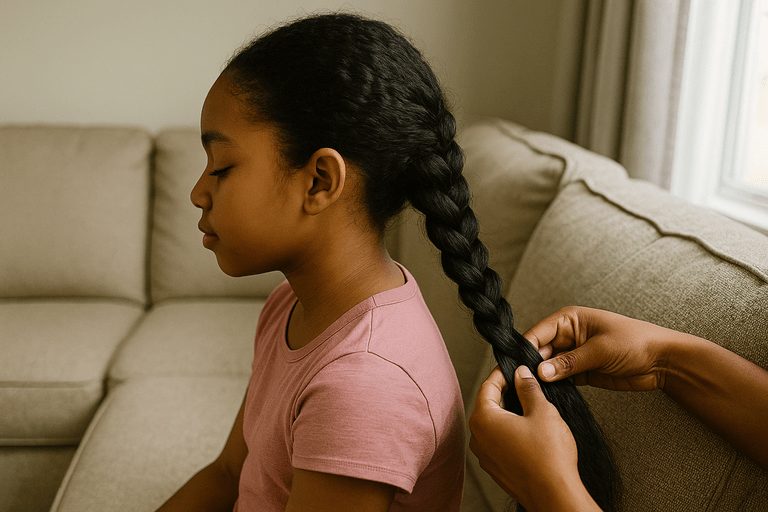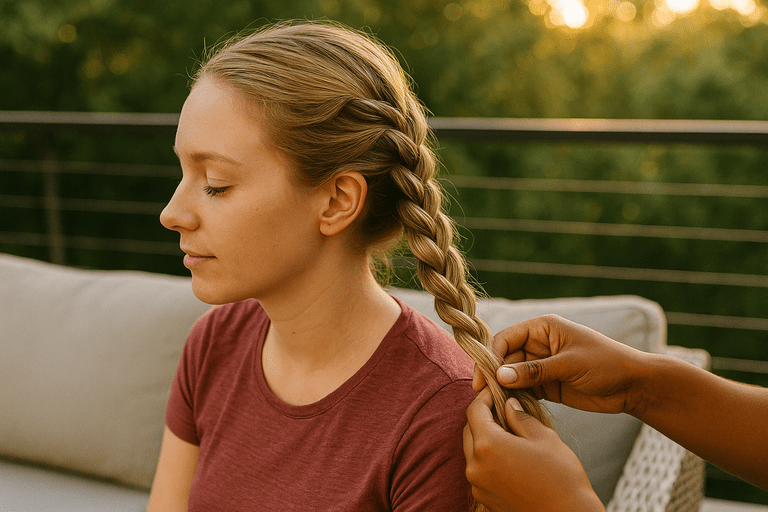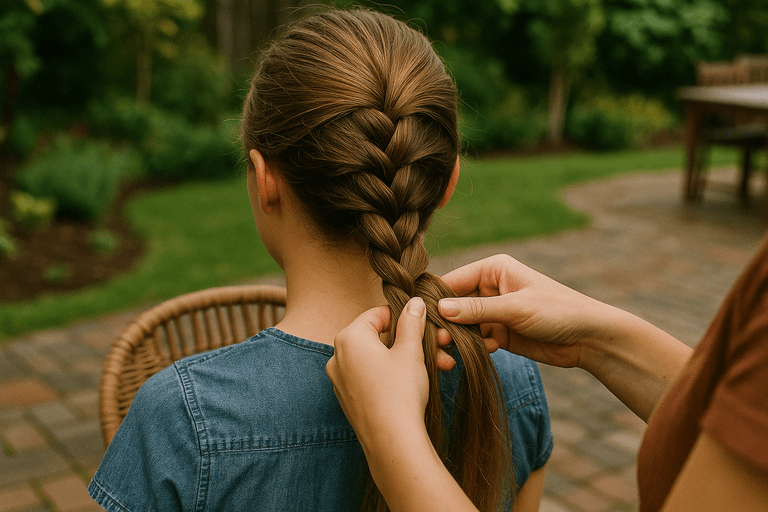French braids never go out of style. They’re timeless, elegant, and practical—perfect for casual days, workouts, or even formal events. But many still ask how to do a french braid that actually looks neat and stays in place. With the right method and a little patience, anyone can learn this classic look.
The beauty of the French braid lies in its structure. It keeps your hair secure while adding a touch of sophistication to any outfit. Whether you have straight, curly, or wavy hair, learning to French braid can completely transform your styling routine.
What You’ll Need Before You Start Braiding
Before diving into the braid itself, gather your tools. You’ll need a brush or wide-tooth comb, a hair tie, and optionally, a bit of texturizing spray or dry shampoo for added grip. If your hair is silky or freshly washed, it might slip through your fingers too easily.
To fully understand how to do a french braid successfully, you must start with tangle-free hair. In addition, slightly dirty hair (day two or three) typically holds braids better than freshly washed locks. If needed, dampen your hair with a spray bottle to reduce frizz and help the strands stay together more easily.

How to Do a French Braid: The Basic Technique
Start by sectioning off a portion of hair from the top center of your head. Divide it into three equal parts. Begin the braid as you would a traditional one: cross the right strand over the center, then the left over the center. Now, here’s where the French braid differs.
Before crossing each section, add a small amount of loose hair from the sides of your head. This action creates the iconic “woven” look of the French braid. If you’re asking how to do a french braid that’s tight and even, make sure you add equal sections from each side and pull gently to maintain tension.
How to Put My Hair in a Bun Step by Step
Repeat this process until you reach the nape of your neck. From there, continue with a regular three-strand braid to finish. Secure with an elastic, and use a mirror to check for bumps or loose sections. If you like a softer look, gently tug on the sides of the braid to loosen it for a relaxed, boho feel.
Braiding for Different Hair Types and Textures
Every hair type responds differently to braiding. Fine, straight hair may need extra texture, while thick, curly hair might require detangling and sectioning in advance. Regardless of your hair type, you can still master how to do a french braid that feels secure and looks polished.
For curly hair, work in smaller sections to avoid breakage and use a leave-in conditioner to control frizz. On the other hand, for fine hair, add dry shampoo at the roots for more grip. In addition, if your hair is layered, be prepared for some strands to pop out—just secure them with bobby pins for a clean finish.
How to Do a French Braid on Yourself
Braiding someone else’s hair is one thing—but doing it on your own head is another level. It takes practice, good mirror angles, and a bit of patience. However, once you get used to the hand placement, it becomes much easier.
So how to do a french braid on yourself without creating a tangled mess? Start by practicing with a side braid where you can see more clearly. Use both hands to separate and cross sections, and don’t be afraid to pause and comb through knots. After a few tries, your muscle memory will improve, and your braids will look better each time.
How to Do a French Braid With a Modern Twist
Once you’ve learned the classic method, it’s time to experiment. Adding a modern twist to your French braid keeps the look fresh and personal. For instance, braid only halfway down and leave the rest of the hair loose for a relaxed, half-up style. Or, start the braid off-center for a playful, romantic vibe.
If you’re still asking how to do a french braid with a unique touch, consider weaving in a ribbon or colored extension. This adds contrast and style without requiring a complicated new technique. In addition, parting your hair in the center or creating double French braids on each side opens the door to dozens of creative looks.
How to Style Bangs Side Swept: A Complete Guide
Moreover, incorporating a fishtail or Dutch braid technique after the French base can transform your braid into a statement piece. These combinations are especially eye-catching for festivals, special occasions, or photo shoots.

French Braids for Different Occasions
French braids adapt to almost any setting. For professional environments, a tight, low French braid looks clean and polished. Pair it with a blazer or minimalist dress for a look that’s sophisticated yet practical. On the other hand, a loose, high braid with pulled-out strands adds softness—perfect for weekend outings or coffee dates.
So how to do a french braid that suits every event? Adjust the tension, placement, and finish. For workouts, choose a tighter braid to minimize movement. For weddings or formal gatherings, consider braiding in fresh flowers or delicate pins to elevate the style.
In addition, French braids are excellent for travel. They keep your hair secure, reduce frizz, and transition well from day to night. Once you know how to adjust your braid to the moment, it becomes your most dependable hairstyle.
Common Mistakes and How to Fix Them
Even experienced braiders make mistakes. One of the most common errors is uneven tension. If one side is tighter than the other, your braid will curve or appear lopsided. Always use a mirror to check symmetry as you go. Another issue is starting too low on the head, which makes the braid sag.
If you’re still struggling with how to do a french braid that holds its shape, here’s a tip: section hair evenly and keep your hands close to your scalp as you braid. Also, resist the urge to pull too hard. While tension is important, overly tight braids can cause scalp discomfort and even hair breakage.
Furthermore, skipping prep is a major mistake. Clean hair needs product to hold. Use dry shampoo, mousse, or a light hairspray before braiding to give your hair enough grip and texture to maintain structure.
How to Do a French Braid on Wet Hair
Braiding wet hair has its benefits. It helps eliminate frizz and keeps the style looking sleek. Plus, once your braid dries, it leaves behind gorgeous waves. However, there are a few things to keep in mind. Wet hair is more fragile, so detangle gently and avoid tight tension.
Learning how to do a french braid on damp hair means being patient and gentle. Use a wide-tooth comb and start at the crown with soft, clean sections. In addition, apply leave-in conditioner or serum to add shine and reduce friction. This method works especially well if you’re looking for overnight styling that looks great the next day.
Just make sure to avoid sleeping with a soaking wet braid—it could lead to scalp discomfort or mildew in your hair. Slightly damp is ideal, especially if you plan to take the braid out in the morning for heat-free waves.

Caring for Your Hair After Braiding
Maintaining your hair’s health after braiding is just as important as the styling process itself. Gently remove the braid by taking out the elastic and unraveling the hair with your fingers. Avoid pulling or yanking—use a detangling spray if needed.
If you often practice how to do a french braid, be sure to moisturize your hair regularly, especially at the ends. Braiding too often or too tightly can put stress on the hair shaft, so alternate your styles and give your scalp rest days.
In addition, always wash out styling products thoroughly. Residue buildup can weaken strands over time. Regular deep conditioning treatments and trims will also help keep your hair strong and beautiful no matter how often you braid.
Quick Recap
Here’s a summary of everything you need to remember about how to do a french braid:
- Start with prep: Clean, tangle-free hair with some grip holds best.
- Use the right method: Add small sections with each cross-over to build the braid.
- Match to hair type: Adjust your approach for curly, fine, or thick textures.
- Practice on yourself: Use mirrors and repetition to improve your technique.
- Get creative: Try half-up styles, side braids, or add ribbons for variety.
- Adjust for occasion: Modify placement, size, and tightness based on where you’re going.
- Avoid common errors: Watch out for uneven tension or slippery hair.
- Try it wet: Damp braiding creates sleek looks and beautiful waves.
- Protect your hair: Moisturize, avoid tight braids daily, and care for your strands post-style.
Final Thoughts: Confidence Through Craft
Mastering how to do a french braid is more than just learning a hairstyle—it’s building a timeless skill that serves you in every phase of life. From casual mornings to formal events, the French braid brings elegance, practicality, and personal expression all in one.
With enough practice, you’ll be able to create this style in minutes, turning a simple braid into a polished, confidence-boosting look. So, grab your brush, find a mirror, and start braiding—you’ve got this.

